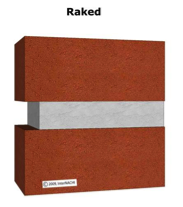Fretting mortar is a common problem for brick and stone homes, especially in homes built without Portland cement in the
cement-mixing ratio. Essentially fretting mortar is where the mortar between brickwork begins to ‘fret’ or fall away. If you spot it early there’s a good chance you can escape any major structural damage and a potentially large repair bill.
What causes it?
Fretting mortar is caused when cement joints become damp or where a badly mixed batch of mortar was used during construction. This can happen in a number of ways including:
- Exposure to the elements
- Reticulation or pool water spraying on the brickwork
- Incorrect mixing of mortar at the time of build
Fretting mortar can be particularly prevalent in homes with ‘raked’ joints (See picture), as water sits within the joint slowly eating away at the mortar.

How to spot it
Fretting mortar is pretty easy to spot. When you’re inspecting your external brickwork have a look at the mortar joints. If you see any crumbling or powdery mortar it’s a good indication that your brickwork is fretting. In its advanced stages the mortar will be almost completely missing. At that point the rows of bricks may begin to collapse onto the bricks below. Be prepared for an expensive repair job if it gets to that stage.
How to fix it
There’s only one way to fix the problem and that’s to replace the mortar (also called re-pointing). Re-pointing is the best way to ensure the structural integrity of your home and to make sure fretting mortar isn’t an ongoing problem. Re-pointing is done by cutting or raking out the fretted joints and replacing them with a correctly mixed mortar. It’s usually a simple, straightforward job that can be completed by a competent bricklayer. More information can be found via our blog on re-pointing mortar joints.
Regular inspection is the only way to avoid fretting mortar becoming an issue on your home. If any unnecessary moisture is penetrating your mortar joints, make every effort to redirect it (such as broken reticulation fittings or leaking downpipes). Be sure to engage in a suitably qualified contractor before the fretting joints become a structural issue.
